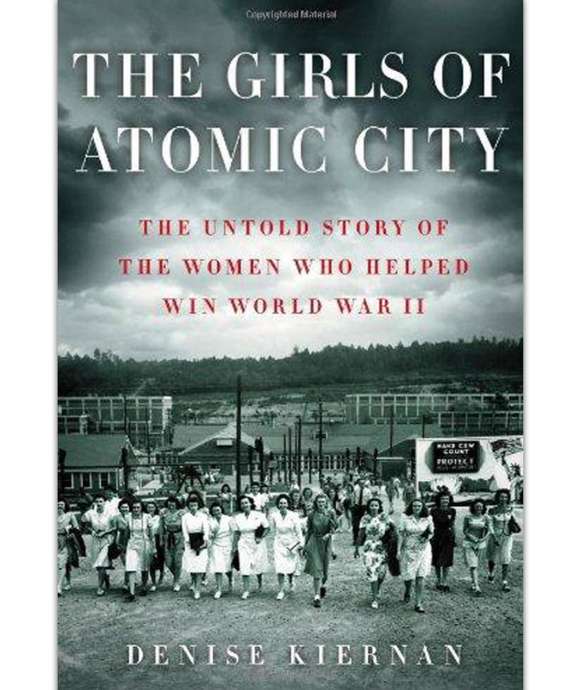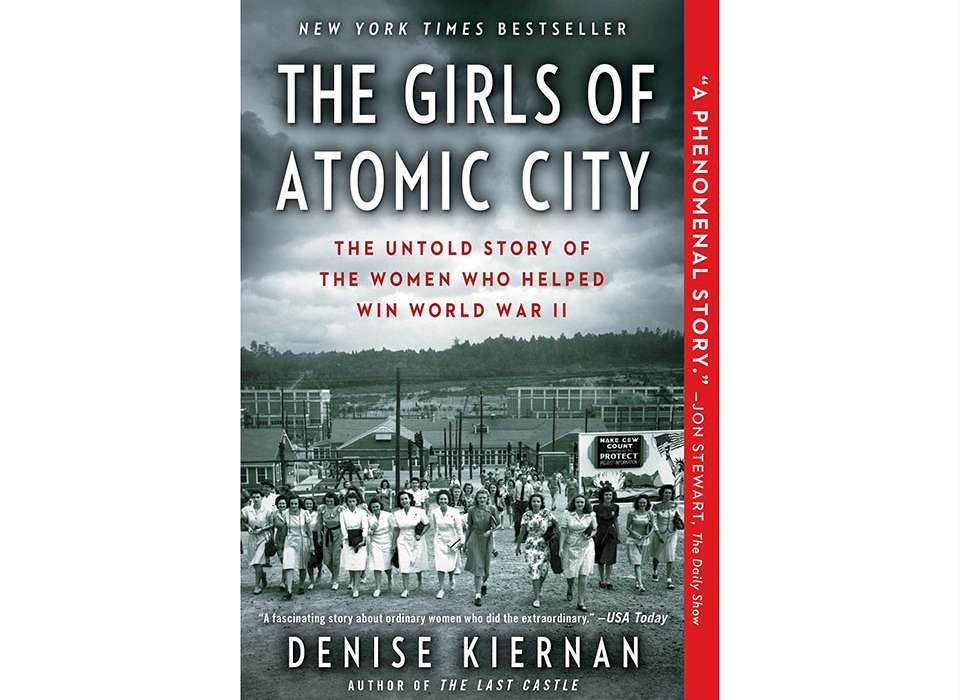As we celebrate women in World War II, it is a time to recognize their often overlooked contributions in our history. One of the more recent and interesting books on this theme is Denise Kiernan’s The Girls of Atomic City: The Untold Story of the Women Who Helped Win World War II. Kiernan’s story is about the central role of women in establishing a sense of community in a place that didn’t exist before the war, where people from many differing social backgrounds had to work together to make successful a project that none of them actually knew what they were creating, and that ultimately the conclusion of the war depended upon: the uranium enrichment facilities at Oak Ridge, Tennessee.
Codenamed Site X, work on the Clinton Engineering Works in a 17 mile-long valley in rural Tennessee originally envisioned the creation of a town of 13,000 people when General Leslie Groves ordered construction to begin in September 1942. But the little town exploded in growth. By spring 1943, there were 300 miles of paved roads and 55 miles of railroad tracks within the valley that could only be accessed through seven gates. Prefabricated housing sprung up within for dormitories, apartments, and homes, although never in enough supply, and trailers with mud in the wet and dirt in the dry times were constant inconveniences. By 1945, over 75,000 people lived within Site X, where over 82,000 employees worked, which meant that on any given day over 100,000 people were on the property. On a daily basis a fleet of 800 buses moved 120,000 passengers daily, while 17 cafeterias served over 40,000 meals. On the grounds were schools, a newspaper, grocery stores, a post office, laundries, and even entertainment with buildings for restaurants, dances, movies, skating, and even a rolling library.
None of it appeared on a map. It was all secret, part of the Manhattan Project to build an atomic bomb. Billboards placed at entry points and within the compound reminded the inhabitants not to talk about their work, admonishing them in one famous message:
“What you see here, What you do here, What you hear here, When you leave here, Let it stay here.”
In the secret town, the biggest secret amongst the inhabitants was that the vast majority of them did not know what they were working on.
Following the stories of several women who lived and worked on Site X, Kiernan shows how the commitment of these women to contribute to the war effort, their courage in the face of obstacles, and their resilient spirits made the women at Oak Ridge the glue that held together not only the daily labors at a top-secret industrial war site, but also the social experiment that was the creation of a small city from thin air. In Oak Ridge, what women found was rushed, temporary, and socially fragmented due to the exigencies of war. But they made homes, forged a community, and thus gave Oak Ridge a life of its own that outlasted the wartime emergency.
Women were everywhere in Oak Ridge, staffing positions from janitors and cooks to saleswomen, chemists, accountants, managers, phone operators, and administrators. They worked in offices from payrolls and personnel to machine shops, chemical processing, and censors for the mail. Given the secrecy of the project, speculation about what words or phrases might be worthy of censorship was rife. Social life went on: single women dated, fell in love and married, and had children in their time at Oak Ridge; married women often moved their entire family, sometimes with up to nine children, into Oak Ridge where they could all find work.
Perhaps, the most mysterious position within Oak Ridge were the women who became calutron operators. Their work involved sitting on a high stool for an eight hour shift (there were three daily shifts beginning at 7am, 3pm, and 11pm) in rooms with high ceilings, concrete floors, electrical noises, and harsh lighting, watching a series of needle gauges and adjusting a series of knobs which balanced the needle readings in the center of the gauges. They learned from supervisors that a high “R” reading was good, there were “M,” “K,” and “G” voltages to watch, and that an “E” box was collecting the “product.”
The so-called calutron girls did not know it, but they were harvesting uranium.
Those who became too nosy about what exactly they were working on were soon replaced.
One of the leaders of the Manhattan Project, the Nobel physicist Ernest Lawrence, used PhD physicists to operate the calutron he had built at the laboratory at the University of California, Berkeley. Lawrence wanted his physicists to operate the Oak Ridge facilities, but due to labor shortages had to acquiesce to the plan to train farm girls to operate the machinery, which he and his physicists would subsequently monitor and tweak. Lawrence was shocked when Colonel Kenneth Nichols, the administrative head at Oak Ridge, informed him that the farm girls at the controls were far outperforming his PhD physicists in harvesting uranium. A friendly contest was held, and yet again the calutron girls easily outperformed the PhD physicists. Colonel Nichols understood exactly why: having been trained to not ask questions, do as ordered, and focus on the task at hand, these girls had the mindsets of soldiers.
The atomic bombing of Hiroshima exposed to the residents of Oak Ridge and the world the secret of what they had been working on. In all, over 125,000 Americans worked on the Manhattan Project, and most were never aware of exactly what they were building. Just as the war itself, however, the value of Denise Kiernan’s The Girls of Atomic City is in illustrating how it took all Americans to achieve ultimate victory. In lifting up the stories of the women at Oak Ridge, this wonderful social history captures and remembers the everyday women whose voices might at first glance might appear to be small, but whose achievements and character confirmed that they were an integral and indispensable part of the greater effort in World War II.

The Girls of Atomic City
Buy this book at the Museum Store and search more than 350 other titles. Proceeds from purchases made through the Museum Store fund our continuing educational mission.
Keith Huxen
Keith is the former Senior Director of Research and History in the Institute for the Study of War and Democracy at The National WWII Museum.
Cite this article:
MLA Citation:
APA Citation:
Chicago Style Citation:






![Max Fuchs, New York City cantor, sings as Rabbi Sydney [sic] Lefkowitz, Richmond, VA, conducts the first Jewish services from Germany.](/sites/default/files/styles/max_650x650/public/2025-10/image1.jpg)


